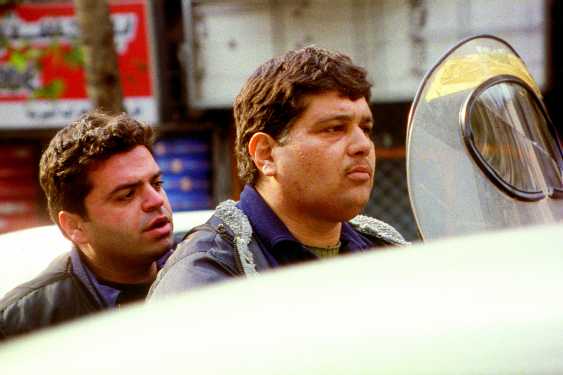

Reviews of Recent Independent, Foreign, & Documentary Films in Theaters and DVD/Home Video
Directed & Produced by: Jafar Panahi. Written by: Abbas Kiarostami. Director of Photography: Hossain Jafarian. Edited by: Jafar Panahi. Music by: Peyman Yazdanian. Released by: Wellspring. Country of Origin: Iran. 97 min. Not Rated. With: Hussein Emadeddin, Kamyar Sheissi & Azita Rayeji.
A heist at a jewelry store goes terribly wrong, and from the sidewalk outside,
passers-by share our experience of watching in horror as events unfold. So
begins the latest film from Iranian director Jafar Panahi (The White
Balloon, The Circle). After this remarkable beginning, the film flashes
back in time becoming a meditation on the circumstances that led a good-hearted
person to this act of desperation. At the center of the film is a pizza
deliveryman named Hussein Emadeddin, played (in true Panahi fashion) by a
pizza deliveryman named Hussein Emadeddin. As in his previous films, Panahi
reveals himself to be a masterful urban director. Hossain Jafarian’s camera follows
Hussein on his motorbike through the streets of Tehran, revealing the discrepancy
between the lives of the haves and the have-nots. The screenplay, by the legendary
Iranian writer and director Abbas Kiarostami, contains moments of bittersweet
humor, such as when Hussein finds himself caught in a police stake-out
at an upper-class party. He responds by passing out free pizza to everyone
involved. But the film’s real revelation is Hussein Emadeddin. Defying
expectations about “non-professional” actors, he gives a superbly controlled and
quietly moving performance, conveying with heartbreaking sincerity the reactions
of a sensitive man to one humiliation after another. He and his
brother-in-law-to-be (Sheissi) are taken for pick-pockets; a jeweler (Vaziri) refuses to even let him into his store, and then informs
Hussein that if he wants to buy jewelry for his fiancée (Rayeji, who appears
all too briefly in a beautiful performance) he should try the gold
souks in the “lower” part of town. Hussein’s round face, with his woolen cap
pulled over his sleepy eyes, registers each blow quietly, until the final scene
returns us to the moment when resignation turns to violence. Crimson
Gold is not without its flaws: several of the supporting characters are
two-dimensional, and Panahi can be heavy-handed in his political swipes against
Iranian society, as he was in the much more polemical The Circle. But
there is no doubting Panahi’s artistry, and the viewer will come away remembering
the unexpected pleasures of certain scenes: a gorgeous shot of the Tehran skyline
interrupted by a drunken burp, or a seemingly endless ride in an elevator that
provides a brief glimpse into Hussein’s weary and ravaged heart. Anthony Alessandrini, Near Eastern Studies, New York University
|